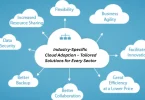Introduction
In today’s fast-changing digital world, cloud computing is evolving faster than ever. New technologies are transforming how businesses work, store data, and serve customers. As we move through this year, Cloud Computing Trends 2025 – Future Technologies & Innovations are shaping the future of IT and digital transformation. From AI-powered services to green cloud solutions and edge computing, there’s a lot happening in the cloud space. This blog will help you explore the latest trends and what they mean for your business in 2025.
What is Cloud Computing Trends 2025?

Cloud Computing Trends 2025 refers to the latest technologies, innovations, and changes happening in the world of cloud computing this year. These trends show how cloud services are evolving to become smarter, faster, more secure, and eco-friendly. In 2025, cloud computing is not just about storing data online—it’s about using advanced tools like artificial intelligence, edge computing, and sustainable infrastructure to improve business performance. These trends help companies stay competitive, reduce costs, and deliver better digital experiences to their users.
You may also like it:
Cloud Compliance Requirements – Ensure Secure & Lawful Cloud Operations
Securing Multi-Cloud Environments – Strategies for Safer & Smarter Cloud Protection
Top Cloud Security Tools 2025 – Protect Your Data with Trusted & Powerful Solutions
Why Cloud Computing Trends 2025 Are Important
Understanding these trends is key to staying ahead in a competitive digital world. Here’s why they matter for businesses, IT teams, and everyday users.
Helps Businesses Stay Competitive
- Keeps You Updated with Innovation
Adopting new cloud technologies helps companies stay current with the latest digital tools. This leads to better customer service and faster growth. - Improves Decision Making with AI
Trends like AI-powered cloud platforms offer real-time insights. This helps businesses make smarter, data-driven decisions. - Supports Remote and Global Teams
Cloud trends support hybrid work models with better collaboration tools. This makes it easier to manage remote and distributed teams.
Enhances Security and Data Protection
- Stronger Security with Zero Trust
New cloud security trends use Zero Trust models to reduce risks. This protects sensitive data from cyberattacks. - Real-Time Threat Detection with AI
AI tools now monitor and detect threats instantly. This helps prevent data breaches before they cause damage. - Compliance with Global Regulations
Trend-driven cloud services follow updated privacy laws. This ensures your business meets legal and industry requirements.
Enables Scalability and Flexibility
- Easily Scales with Business Growth
Cloud trends allow systems to expand as your business grows. You don’t have to worry about infrastructure limits. - Custom Solutions for Different Industries
Industry-specific clouds meet unique business needs. This flexibility makes operations more efficient. - Pay-as-You-Go Models Save Costs
Cloud platforms offer flexible pricing based on usage. You only pay for what you use, reducing waste and cost.
Drives Sustainable and Green IT Practices
- Reduces Carbon Footprint with Green Cloud
New eco-friendly trends focus on clean energy data centers. This helps businesses lower their environmental impact. - Optimizes Energy Usage in Data Centers
Trends in 2025 include smarter resource management. This leads to reduced energy use and operational costs. - Promotes Responsible Tech Growth
Sustainability in cloud computing encourages long-term planning. It shows customers you care about the planet.
Step-by-Step Guide to Embrace Cloud Computing Trends 2025

Step 1: Understand the Latest Cloud Trends
- Read Industry Reports & Blogs
Stay informed by reading updated tech blogs, whitepapers, and reports on cloud trends from trusted sources like Gartner, IDC, or major cloud providers. - Identify Key Trends That Matter
Focus on trends like AI integration, edge computing, sustainability, and hybrid cloud. These are shaping the way businesses operate in 2025. - Track What Competitors Are Doing
Analyze how similar businesses are using cloud trends to grow. Learn from their strategies to stay ahead in your industry.
Step 2: Evaluate Your Current Cloud Infrastructure
- Assess Existing Cloud Tools & Services
Review your current cloud setup to identify what’s working and what needs improvement. This helps prepare for upgrades. - Check for Gaps in Technology or Security
Look for outdated systems or weak points in security. This ensures your business is ready for modern cloud practices. - Consult IT Teams or Cloud Experts
Work with internal IT staff or third-party experts to evaluate readiness for adopting new cloud technologies.
Step 3: Choose the Right Trends to Implement
- Align Trends with Business Goals
Not all trends are useful for every business. Select those that support your growth, scalability, or customer needs. - Start Small with Pilot Projects
Test new technologies like AI or serverless computing on a small scale. Measure performance before a full rollout. - Consider Costs and ROI
Evaluate the cost, time, and resources needed. Make sure the trend you choose brings value to your business.
Step 4: Upgrade Cloud Strategy and Tools
- Use Multi-Cloud or Hybrid Cloud Models
Adopt flexible cloud architectures to avoid vendor lock-in. Hybrid and multi-cloud setups offer better control and performance. - Integrate AI and Automation Tools
Use cloud-based AI tools to automate workflows, monitor systems, and boost decision-making in real time. - Enhance Security with Zero Trust & AI
Update security frameworks to include real-time monitoring, threat detection, and strict access controls.
Step 5: Train Teams and Monitor Progress
- Upskill Employees on New Tools
Provide training sessions and workshops so your team can adapt to new cloud platforms and features. - Track KPIs and Cloud Performance
Set clear goals and monitor usage, costs, and system performance regularly to measure success. - Stay Agile and Ready to Evolve
Cloud technology changes fast—stay flexible and ready to adopt new innovations as they emerge.
Advantages and Disadvantages of Cloud Computing Trends 2025
| Advantages | Disadvantages |
| Improved Efficiency with AI & Automation Modern cloud platforms use AI to automate tasks, analyze data, and improve system performance. This saves time and reduces human error. | High Initial Complexity for Small Teams Adopting new cloud trends may require technical knowledge or training. Smaller teams may struggle with setup and integration. |
| Better Flexibility and Scalability Businesses can scale resources up or down easily based on demand. This means you’re never overpaying or underpowered. | Data Privacy and Compliance Challenges Managing data across different regions and clouds can create compliance issues. It’s vital to understand and follow data regulations. |
| Enhanced Data Security With Zero Trust models and real-time threat detection, cloud platforms in 2025 offer stronger protection against cyber threats. | Vendor Lock-In Risks Using advanced features from one cloud provider may make it harder to switch later. Multi-cloud strategies can reduce this risk. |
| Cost Savings Through Pay-as-You-Go Models You only pay for what you use, avoiding the high costs of traditional IT infrastructure. This makes cloud ideal for businesses of all sizes. | Ongoing Costs Can Add Up While cloud is cost-effective, continuous usage, premium features, and scaling needs can increase expenses over time. |
| Supports Remote and Hybrid Work Cloud tools improve collaboration and access, making it easier for remote teams to stay productive and connected. | Downtime and Internet Dependency Cloud services rely on internet connectivity. Any disruption in service or outages from the provider can affect operations. |
You may also like it:
Cloud Security Best Practices 2025 – Protect Your Data with Smarter & Safer Strategies
Real-Time Data Processing with AI – Faster Insights & Smarter Decisions
Top Benefits of AI Cloud Integration – Smarter Faster & Scalable Business Solutions
Frequently Asked Questions (FAQs)
What are cloud computing trends in 2025?
Cloud computing trends in 2025 include AI-powered tools, green cloud solutions, edge computing, stronger security, and hybrid cloud models. These trends help businesses work smarter and faster.
Why should my business care about these trends?
Following cloud trends keeps your business competitive, secure, and efficient. It helps you save costs, stay up to date, and serve customers better.
Is it expensive to adopt new cloud technologies?
Not always. Many cloud services offer pay-as-you-go pricing. You can start small, test features, and expand as your needs grow.
Are cloud services safe in 2025?
Yes, most modern cloud platforms offer strong security features like Zero Trust, data encryption, and AI threat detection. Still, it’s important to follow best practices.
What is green cloud computing?
Green cloud computing uses energy-efficient data centers powered by renewable energy. It helps reduce carbon footprints and supports eco-friendly IT.
What is edge computing, and why is it trending?
Edge computing means processing data closer to where it’s created (like on devices or local servers). It reduces delays and is great for real-time apps and IoT.
How can small businesses benefit from these trends?
Small businesses can use cloud trends to cut IT costs, automate tasks, improve security, and easily scale as they grow.
Conclusion
Cloud computing in 2025 is smarter, faster, and more secure than ever. With trends like AI, green cloud, edge computing, and hybrid models, businesses have more tools to grow, save costs, and protect their data. By staying updated and choosing the right cloud solutions, you can keep your business future-ready and competitive in the digital world.
Bonus Points
- Cloud-Native Applications Are on the Rise
More businesses are building apps directly in the cloud instead of just moving existing ones. This improves performance and reduces maintenance. - AI-as-a-Service (AIaaS) Gaining Popularity
Companies can now access powerful AI tools without building their own. This makes AI more affordable and scalable for all business sizes. - Cloud Certifications Are In-Demand
IT professionals with cloud certifications (AWS, Azure, Google Cloud) are highly valued. Upskilling in 2025 can open new career opportunities. - FinOps for Better Cloud Cost Management
Cloud financial operations (FinOps) help teams track and control cloud spending. It brings finance, IT, and business teams together. - Cloud Gaming and VR Are Growing
Trends in cloud computing are also powering entertainment. Cloud-based gaming and VR streaming are improving speed and user experiences.
You may also like it:
AI-Driven Cloud Analytics – Smarter Data Insights for Modern Businesses
Intelligent Cloud Platforms – Smart Scalable & Secure Computing Solutions
Top Cloud-Based Machine Learning Tools in 2025 – Features Benefits & Use Cases
AI in Cloud Computing 2025 – Latest Trends Innovations & Future Insights





